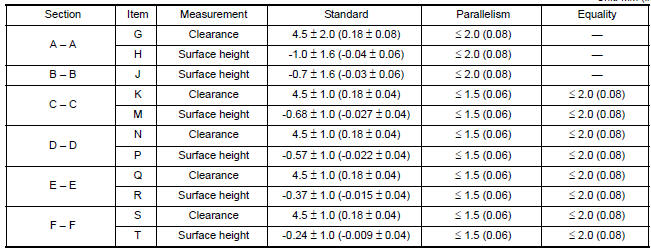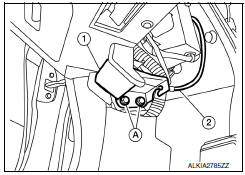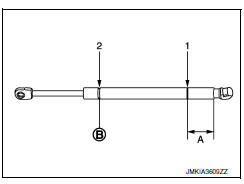Nissan Maxima Service and Repair Manual: Hood
HOOD ASSEMBLY
HOOD ASSEMBLY : Exploded View

- Hood hinge cover (LH)
- Hood stay (LH)
- Hood hinge (LH)
- Hood assembly
- Hood bumper rubber
- Seal
- Hood insulator
- Hood insulator clips
HOOD ASSEMBLY : Removal and Installation
CAUTION:
- Use two people when removing or installing hood assembly due to its heavy weight.
- Use protective tape or shop cloths to protect surrounding components from damage during removal and installation of hood assembly.
REMOVAL
- Support the hood assembly using a suitable tool.
- Remove hood hinge to hood nuts (A) and then remove the hood assembly (1).
WARNING: Bodily injury may occur if hood assembly is not supported properly when removing hood assembly.

INSTALLATION Installation is in the reverse order of removal.
CAUTION:
- After installation, perform the hood assembly adjustment procedure.
- When replacing hood stay(s)
HOOD ASSEMBLY : Adjustment

- Hood assembly
- Front fascia
- Front fender
FRONT END HEIGHT ADJUSTMENT AND LATERAL/LONGITUDUNAL CLEARANCE ADJUSTMENT
Check the clearance and the surface height between hood and each part by visual inspection and tactile feel.
If the clearance and the surface height are out of specification, adjust them according to the adjustment procedures.

FRONT END HEIGHT ADJUSTMENT
- Remove the core support cover clips, then remove the core support cover.
- Remove the hood lock. Refer to DLK-205, "HOOD LOCK CONTROL : Removal and Installation".
- Adjust the surface level difference of the hood, fender and front fascia by rotating the hood bumpers until the hood becomes 1 to 1. 5 mm (0. 04 to 0. 06 in) lower than the fender.

- Install and align the hood lock center with the center of the hood striker. Engage the lock with the striker and check for looseness. \
- Adjust (A) and (B) shown in the figure to the specified value with hood's own weight by dropping it from approx. 200 mm (7. 9 in) height or by pressing the hood closed lightly approximately 29 N (3. 0 kg, 6. 5 lb).

- Hood striker
- Primary latch
- Secondary latch
- Secondary striker
- 20 mm (0. 8 in)
- 6. 8 mm (0. 27 in)
- After adjustment tighten the hood lock bolts to the specified torque.
LATERAL/LONGITUDUNAL CLEARANCE ADJUSTMENT
- Loosen the hood hinge bolts.
NOTE:
The anticorrosive agent applied between the hoodledge and the hood hinges
also acts as an adhesive.
This seal must be broken before the hinges will move.
- Move the hood so that the clearance measurements are within specifications provided.
- Tighten the hood hinge bolts to the specified torque. NOTE: After installation apply touch-up paint onto the hinge bolts and around the base of the hinge.
- If the clearance measurements between the hood and fender cannot be corrected by adjusting the hood, the fender must be adjusted.
HOOD LOCK CONTROL
HOOD LOCK CONTROL : Exploded View

- Hood lock assembly
- Hood lock release cable
- Hood lock release handle
- Hood lock release cable clip
 Clip
Clip
HOOD LOCK CONTROL : Removal and Installation
REMOVAL

- Remove the core support cover clips, then remove the core support cover.
- Remove the fender protector (LH).
- Remove the hood lock assembly bolts (
 ).
).

- Disconnect the hood lock release cable from the hood lock, and unclip it from the hoodledge.
- Remove the bolts (A) and separate the hood lock release handle (1) from the hood lock release cable (2).
- Remove the grommet from the upper dash, and pull the hood lock release cable into the passenger compartment.
CAUTION: While pulling, be careful not to damage (peel) the outside of the hood lock release cable.
INSTALLATION
- Pull the hood lock release cable through the upper dash into the
engine compartment.
CAUTION: Be careful not to bend the hood lock release cable too much, keep the radius 100 mm (3. 9 in) or more. - Check that the hood lock release cable is not offset from the center of the grommet and seat the grommet into the upper dash hole.
- Apply the sealant around the grommet at * mark.

- Position the hood lock release cable and clip it into place.

- Connect the hood lock release cable to the hood lock assembly
- Install the bolts to hood lock release handle.
Bolts 10 N?m (1. 0 kg-m, 7ft-lb)
- Loosely install the hood lock assembly.
- Perform hood fitting adjustment. Refer to DLK-203, "HOOD ASSEMBLY : Adjustment".
- Perform the hood lock control inspection. Refer to DLK-207, "HOOD LOCK CONTROL : Inspection".
HOOD LOCK CONTROL : Inspection
INSPECTION
CAUTION: If the hood lock cable is bent or deformed, replace it.
- Check that the secondary latch is properly engaged with the secondary striker with hood's own weight.

- Hood striker
- Primary latch
- Secondary latch
- Secondary striker
- 20 mm (0. 8 in)
- 6. 8 mm (0. 27 in)

- While operating the hood lock release handle, carefully check that the front end of the hood is raised by approx. 20 mm (0. 8 in). Also check that the hood lock release handle returns to the original position.
- Check that the hood lock release handle operating force is 49 N (5. 0 kg, 11. 0 lb) or below.
- Install so the static closing force of the hood assembly is 315 - 490 N*m (32. 1- 50. 0 kg-m, 70. 8 - 110. 2 ftlb).
- Check the hood lock assembly lubrication condition. If necessary,
apply a suitable multi-purpose grease as shown.
 : Grease
: Grease
HOOD STAY
HOOD STAY : Disposal

- Fix hood stay (1) using a vise (C).
- Using hacksaw (A) slowly make 2 holes in the hood stay (1), in numerical order as shown.
CAUTION:
- When cutting a hole on hood stay, always cover hacksaw with a shop cloth (B) to avoid scattering metal fragments or oil.
- Wear eye protection (safety glasses).
- Wear gloves.

A: 20 mm (0. 8 in)
B: Cut at the groove.
 Radiator core support
Radiator core support
Exploded View
Radiator core support
Bolts
Removal and Installation
REMOVAL
Remove front bumper. Refer to EXT-16, "Removal and Installation".
Remove front combinat ...
Other materials:
Radiator
Exploded View
Radiator
CVT oil cooler hose
Radiator drain plug
Radiator hose (lower) clamp
Radiator hose (lower)
Radiator hose (lower) bracket
Reservoir tank
Reservoir hose
Radiator cap
Radiator cap adaptor
Radiator hose (upper)
Radiator hose (upper) clamp
&nb ...
BCM (body control module)
Reference Value
NOTE:
The Signal Tech II Tool (J-50190) can be used to perform the following
functions. Refer to the Signal Tech II
User Guide for additional information.
Activate and display TPMS transmitter IDs
Display tire pressure reported by the TPMS transmitter
Read TPMS DTCs
...
Trunk lid opener
Wiring Diagram
...
Nissan Maxima Owners Manual
- Illustrated table of contents
- Safety-Seats, seat belts and supplemental restraint system
- Instruments and controls
- Pre-driving checks and adjustments
- Monitor, climate, audio, phone and voice recognition systems
- Starting and driving
- In case of emergency
- Appearance and care
- Do-it-yourself
- Maintenance and schedules
- Technical and consumer information
Nissan Maxima Service and Repair Manual
0.007

